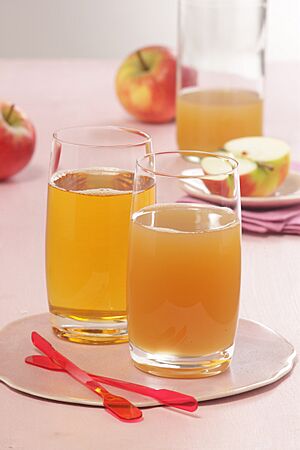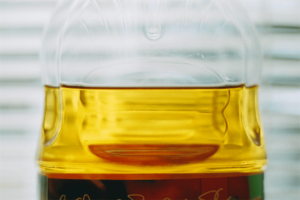Apple juice facts for kids
Apple juice is a popular fruit juice made by crushing and pressing apples. Sometimes, the juice is cleaned up even more by removing tiny bits of starch and pectin that can make it cloudy. After that, it's often pasteurized (heated to kill germs) so it can be stored safely in bottles, cans, or special containers. You can also find it as a concentrate, which means most of the water has been taken out.

Making apple juice in large amounts needs special machines, so it's usually done by big companies. In the United States, you might find fresh, unfiltered apple juice, often called "apple cider," made by smaller farms. Apple juice is one of the most common fruit juices around the world. The top countries that produce it are China, Poland, the United States, and Germany.
Contents
How Apple Juice is Made
Apples for juice are usually picked in the fall (September to mid-November) in the Northern Hemisphere and in the spring (February to mid-April) in the Southern Hemisphere. A common type of apple used is the McIntosh. About two medium McIntosh apples can make around 200 milliliters (about 7 fluid ounces) of juice.
After picking, the apples are washed and sent to the processing factory. They are pressed and juiced quickly to keep them from spoiling. Depending on the company and what kind of juice they want to make, apples might be prepared in different ways before pressing. The juice is then filtered. How much solid stuff is left in the juice helps decide if it's called "apple juice" or "apple cider". If enzymes are used to clean the juice, they are usually a type called pectinases.
Keeping Juice Safe: Pasteurization
Apple juice is a bit acidic, usually with a pH of about 3.4. This means it doesn't need to be heated as long or as hot as some other juices to be pasteurized. Pasteurization is a heating process that kills harmful germs, making the juice safe to drink and store longer.
The U.S. Food and Drug Administration (FDA) suggests certain heating times and temperatures to make sure a specific parasite, Cryptosporidium parvum, is destroyed. This parasite is tougher to kill than some bacteria like E. coli. Here are some examples of how long and hot the juice needs to be heated:
- 160°F (71°C) for at least 6 seconds
- 165°F (74°C) for at least 2.8 seconds
- 170°F (77°C) for at least 1.3 seconds
- 175°F (79°C) for at least 0.6 second
- 180°F (82°C) for at least 0.3 second
Why Pasteurization Matters
Between 2000 and 2010, there were many cases of people getting sick in North America from drinking juice or cider that was not pasteurized. These illnesses were caused by tiny germs like parasites, bacteria, and viruses. Some of the common germs included E. coli, Salmonella, and Cryptosporidium.
Germs can get into juice in many ways. They might be on the fruit when it's picked, or they could come from dirty containers or from not washing the fruit and equipment properly. Pasteurization helps make sure these harmful germs are gone, so the juice is safe for everyone to drink.
What's in Apple Juice?
Apple juice is mostly water, about 88%. It has about 11% carbohydrates, and most of those are sugars. It has very little protein or fat. A small glass (100 ml) of unsweetened apple juice has about 46 calories but not a lot of micronutrients (vitamins and minerals).
Storing Apple Juice
Fresh apple juice that hasn't been pasteurized needs to be kept in the refrigerator. Sealed bottles or cans of apple juice that have been pasteurized can be stored in a cool, dark place, like a pantry or cupboard. This helps keep the juice fresh for a long time. Over time, the juice might change a little in how it looks, feels, or tastes.
Once you open a package of juice, or if it wasn't sealed to begin with, you should close it tightly and put it in the refrigerator. This stops tiny germs like bacteria from growing. The best temperature to store apple juice is between 0°C (32°F) and 4°C (39°F).
Apple Juice vs. Apple Cider
The term apple juice usually means the clear, pasteurized drink made from pressed apples. However, in the United States and parts of Canada, an unfiltered and sometimes unpasteurized version of apple juice is often called "apple cider." Some companies even label their filtered, clear, or fizzy juice as "apple cider" to make it sound more natural. The rules for what can be called "apple cider" can be a bit confusing and vary from place to place.
In other parts of the world, like New Zealand, Australia, and the United Kingdom, the word cider usually means a fermented fruit juice, most often made from apples. This is an alcoholic drink. In North America, this alcoholic version is called hard cider.
See Also
 In Spanish: Jugo de manzana para niños
In Spanish: Jugo de manzana para niños
- Juicing
- List of juices
- Malic acid



